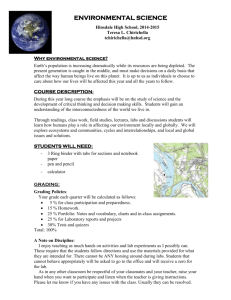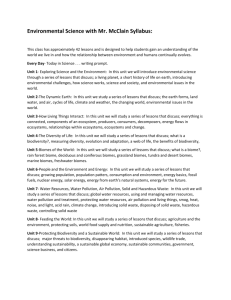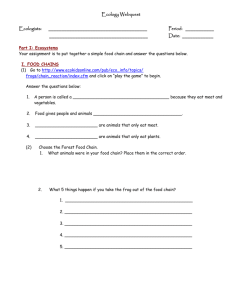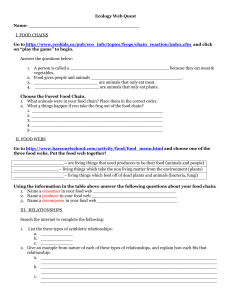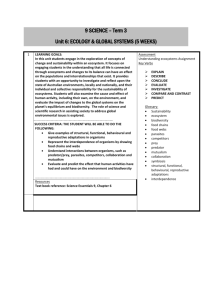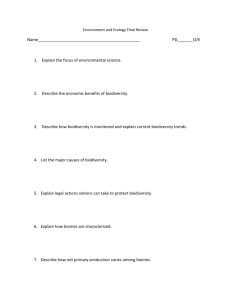AP Environmental Science student Syllabus 2014
advertisement
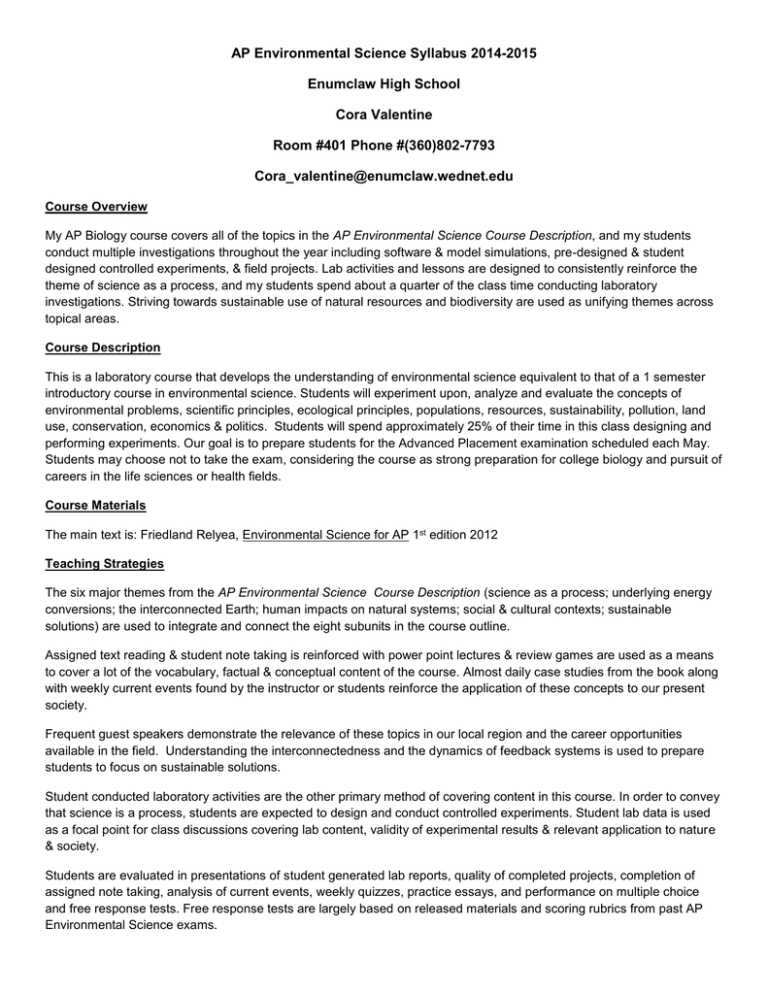
AP Environmental Science Syllabus 2014-2015 Enumclaw High School Cora Valentine Room #401 Phone #(360)802-7793 Cora_valentine@enumclaw.wednet.edu Course Overview My AP Biology course covers all of the topics in the AP Environmental Science Course Description, and my students conduct multiple investigations throughout the year including software & model simulations, pre-designed & student designed controlled experiments, & field projects. Lab activities and lessons are designed to consistently reinforce the theme of science as a process, and my students spend about a quarter of the class time conducting laboratory investigations. Striving towards sustainable use of natural resources and biodiversity are used as unifying themes across topical areas. Course Description This is a laboratory course that develops the understanding of environmental science equivalent to that of a 1 semester introductory course in environmental science. Students will experiment upon, analyze and evaluate the concepts of environmental problems, scientific principles, ecological principles, populations, resources, sustainability, pollution, land use, conservation, economics & politics. Students will spend approximately 25% of their time in this class designing and performing experiments. Our goal is to prepare students for the Advanced Placement examination scheduled each May. Students may choose not to take the exam, considering the course as strong preparation for college biology and pursuit of careers in the life sciences or health fields. Course Materials The main text is: Friedland Relyea, Environmental Science for AP 1st edition 2012 Teaching Strategies The six major themes from the AP Environmental Science Course Description (science as a process; underlying energy conversions; the interconnected Earth; human impacts on natural systems; social & cultural contexts; sustainable solutions) are used to integrate and connect the eight subunits in the course outline. Assigned text reading & student note taking is reinforced with power point lectures & review games are used as a means to cover a lot of the vocabulary, factual & conceptual content of the course. Almost daily case studies from the book along with weekly current events found by the instructor or students reinforce the application of these concepts to our present society. Frequent guest speakers demonstrate the relevance of these topics in our local region and the career opportunities available in the field. Understanding the interconnectedness and the dynamics of feedback systems is used to prepare students to focus on sustainable solutions. Student conducted laboratory activities are the other primary method of covering content in this course. In order to convey that science is a process, students are expected to design and conduct controlled experiments. Student lab data is used as a focal point for class discussions covering lab content, validity of experimental results & relevant application to nature & society. Students are evaluated in presentations of student generated lab reports, quality of completed projects, completion of assigned note taking, analysis of current events, weekly quizzes, practice essays, and performance on multiple choice and free response tests. Free response tests are largely based on released materials and scoring rubrics from past AP Environmental Science exams. Unit 1: Intro to Environmental Science Description: The earth is one interconnected system. Humans are totally dependent on earth’s resources for our survival, yet we have also altered the planet in many ways. In this unit, we will learn how environmental science can help us understand the complex relationships between humans and nature. To do this, we will need to examine sustainability, economic development, and the connections between social, economic and environmental issues in our world today. We will also focus on applying the Scientific Method to environmental problems. Essential Questions: 1) How do humans depend on their environment, and how do they impact it? 2) What tools do environmental scientists use to study our world? 3) What are the social, economic and environmental effects of economic growth and development? 4) What are the major challenges facing the world in the coming century? Unit 2: Environmental Systems: Cycles in Nature Description: Nature is full of complex systems that maintain balance over long periods of time, and in order to understand them, it is necessary to study entire systems instead of isolated pieces of the puzzle. This unit examines how the interactions of earth’s atmosphere, hydrosphere, lithosphere and biosphere create complex cycles that are critical to sustaining life on the planet. We will focus on ecosystems, studying the relationships that develop between organisms and their environment, and the value of those ecosystems to humans. Essential Questions: 1) Which chemical properties affect the behavior of earth’s natural systems? 2) What are the different forms of energy, and what laws govern the flow of energy in a system? 3) How do ecosystems capture and store energy, and how is this energy transferred among organisms in the ecosystem? 4) What is ecology, and how can it help us study the interactions between species in an ecosystem? 5) How do humans rely on ecosystems, and how do they affect them? Unit 3: Variety is the Spice of Life: Biomes and Biodiversity Description: Scientists have discovered over 2 million species on earth, and there may be millions more left to discover – yet this is just 1% of the total number of species that have ever lived on earth! Why are there so many species of life, and how do they change over time? In this unit, we will examine the characteristics of the major types of biomes on earth and how species are adapted to live in each of them. We will also trace the history of life over time, focusing on how species are constantly affected by environmental changes. Essential Questions: 1) What factors create similar climate patterns on distant parts of the earth, and what are the defining features of the common biomes created as a result? 2) How does natural selection allow species to adapt to their environment over time? 3) Why are there so many different species on earth, and what is the value of this biodiversity? 4) How have humans affected each biome and the species within them, and what is the cumulative impact on global biodiversity? Unit 4: Population: 7 Billion and Counting Description: This unit is devoted to the study of populations of organisms in nature, their growth over time, and the limits to their growth. We will also take an in-depth look at the human population of our world, how it has grown and changed over time to reach 7 billion people today, and what might be ahead of us in the future. We will focus on achieving long-term sustainability and improving the quality of life for all mankind. Essential Questions: 1) What factors promote and restrict population growth over time? 2) How do populations of species interact with each other to use resources in the environment? 3) How has the human population grown over time, and what changes have accompanied this growth? 4) What factors affect human population growth rates, and what can we predict global population growth will be like in the future given current trends and statistics? Unit 5: Earth’s Systems and Resources Description: The earth is 4.5 Billion years old and has been through incredible changes. In this unit, we will look at the natural processes that change the earth over time, and how those changes can benefit and threaten humans. We will also examine Earth’s mineral, soil and water resources, as well as current issues regarding sustainable use of these resources and providing access for all people. Essential Questions: 1) How was Earth formed, and what ongoing processes shape the earth and living things on it? 2) How are rocks formed and changed over time, and what can they tell us about the history of our planet? 3) Where are earth’s water resources found, and how do humans use them? 4) How are earth’s water resources distributed amongst the human population? 5) How can humans manage mineral, soil and water resources to ensure sustainable access for all? Unit 6: The Bare Necessities: Land and Food Description: All human activities require land, and our societies have spread to every corner of the globe. In this chapter, we will investigate the major demands humans place on the limited amount of land on Earth and what environmental impacts these demands cause. We will pay special attention to agriculture, and how various practices can harm or benefit the environment. As always, our focus will remain on evaluating the impact of human activities on environmental systems and finding sustainable practices. Essential Questions: 1) What are humanity’s demands on Earth’s land resources, and what limits exist on those resources? 2) What organizations and policies can promote sustainable land use, and how? 3) What practices characterize modern industrial agriculture, and what are its benefits and drawbacks? 4) How can we reduce the impact of agriculture on the environment and promote sustainability? Unit 7: Energy Resources and Consumption Description: The Industrial Revolution completely transformed human society and its impact on the environment. Much of this change came from the increased use of fossil fuels, which enabled humans to enormously magnify their productive capabilities and increase the quality of life for billions of people around the planet. Yet these fossil fuels are limited in supply and come with large environmental effects, so their use is not sustainable in the longterm. At the same time, billions of people around the world desperately need more cheap energy to improve their standard of living. In this unit, we will investigate how humans utilize fossil fuels, and investigate alternative, renewable, sustainable sources of energy. Essential Questions: 1) What are the major human uses for energy, and how does it underpin modern society? 2) How are coal, oil and natural gas extracted and utilized, and to what extent are they sustainable? 3) What steps are necessary to make our society more energy efficient and sustainable? 4) What are the advantages and disadvantages of solar, wind, geothermal, hydroelectric, biomass and hydrogen energy? Unit 8: So Fresh and So Clean: Water and Air Pollution Description: One result of humanity’s dramatic increase in resource consumption in recent centuries is the generation of large amounts of pollution. The atmosphere and oceans are large commons in to which much of this pollution is discharged. In this unit, we will examine specific harmful pollutants – along with their sources and effects – as well as the technologies and legislative responses that have addressed pollution problems with varying degrees of success. Our emphasis will be on case studies. Essential Questions: 1) How is human wastewater treated, and what effects can it have if it contaminates water bodies? 2) What are the major chemical pollutants found in water, and are the sources and effects of each? 3) What are the main air pollutants of concern, and what are the sources and effects of each? 4) What air pollutants drive the complex problems of smog, acid deposition and ozone depletion occur? 5) What technologies and regulations address air and water pollution, and how effective have they been? Unit 9: Waste Management, Human Health and Environmental Risks Description: As human societies have grown in size and affluence, they have begun to generate waste which cannot be easily broken down or used by natural processes. There are many ways to reduce and to deal with this waste, but each come with environmental and economic tradeoffs. Increasing population densities and technological development have also lead to new threats to human health. In this unit, we will examine the major impacts of waste and development on human health, and how we can manage the risks they pose. Essential Questions: 1) What unique problems does human waste generation pose to the environment, and what products and practices are most responsible for waste generation? 2) How do we currently handle solid waste disposal, and how can we improve waste management to reduce waste on a personal and societal level? 3) What are the major threats to human health on local and global levels, and how have they changed over time with technological development? 4) How can risk analysis and risk management help us evaluate the severity of various risks and minimize threats to human health? Unit 10: Global Change in the Age of Man Description: Throughout this course we have explored the natural world and humanity’s impact on it, particularly in the last 300 years when the bulk of population growth and economic development has occurred. In this unit, we will delve in to detail in examining the 2 broadest and most serious threats to the sustainability of the human species: biodiversity loss and climate change. Both of these phenomena are have accelerated in recent decades, but fortunately we have many opportunities to address these problems before they get worse. We will focus on specific evidence, specific impacts and specific solutions. Essential Questions 1) What are the causes and effects of the ongoing global loss of biodiversity? 2) How can we respond to this crisis to ensure continued biodiversity? 3) How has climate change already affected our world, and what future effects are projected? 4) How can humanity address climate change while still providing economic growth for billions of people? Grading 50% - Assessments (tests and quizzes) 35% - Labs and Projects 15% - Assignments A = 90%-100%, B = 80% - 89%, C = 70% - 79%, D = 60% - 69%, F = 59% and under Supplies Every APES student is required to have the following in class everyday: Composition notebook, college ruled Pencils Colored pencils Highlighter Scissors Glue stick Notebook paper Folder or binder to keep track of assignments Calculator (does not have to be complex) Absences If you are absent, please see my swift site for daily activities and assignments. http://swift.enumclaw.wednet.edu/ehs/valentine/welcome Make-up Policy The teacher will reschedule missed tests during CORE/CHOICE, before or after school. Missed tests or Make-up work is due within FIVE SCHOOL DAYS of returning to school. You may not make up work from unexcused absences. Late Work You may turn in Late work for a particular unit until the end of the unit test. You may not turn in late work from unexcused absences Tutoring I will be available anytime between 7:30 – 7:55 in the mornings, during CORE/CHOICE and 2:40-3:00 in the afternoons if you have any questions or concerns about the class. Procedures You will find that I am a very fair and understanding person. However, I do expect students to follow some important guidelines to ensure that everyone in class is learning. Follow all district and school rules Participate Respect yourself and others at all times Respect all property Follow directions the first time given Be seated in your assigned seat when the bell finishes, or you will be tardy Come prepared to class (notebook, paper, writing utensil, etc…) No food, drink, or applying makeup in classroom NO CELL PHONES Pickup after yourself DO NOT TALK WHILE I AM TALKING No cheating – Automatic zero Consequences – First Offense Verbal warning/ student-teacher conference Second Offense Parent contact Third Offense Administrative referral Severe behavior or disruption Immediate removal from class and referral to office **Severe behavior is any behavior that distracts other students from learning ______________________________________________________________________ AGREEMENT I, ___________________________________ ( print ), have read the Physical Science course syllabus and scope/sequence and agree to abide by the terms in order to succeed in Ms. Valentine’s classroom. Student Signature: _____________________________________ Date: ____________ Parent/Guardian Signature: ______________________________ Date: ____________
